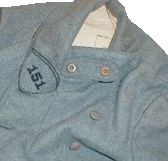Greatcoats
The French capote, or "greatcoat," could be considered the primary garment of the French uniform. It was part of the standard dress worn in all seasons. Exceptions were made to this rule, such as soldiers serving in special roles (machine-gunners, runners, stretch-bearers, etc.), otherwise the greatcoat was to be worn whenever on-duty. For more information on how the greatcoat was worn see the How to Wear Your Kit Correctly page.
Note: All images used without permission. Original sources are cited at bottom of page.
The regulation French greatcoat went through many changes during the war. Soon after the outbreak of war in August 1914 it was realized that the current greatcoat, little altered since the mid-19th century, was ill-suited for use in the current conflict. The color harkened back to a time before powderless gunpowder and made the wearer highly conspicuous on the battlefield. There were no external pockets for the soldier to store the multitude of small kit items (and later extra ammo) and the collar afforded little protection against rain and cold. With the dramatic change to the new, less conspicuous uniform cloth, officially called "light blue," the first of these issues was addressed. But the huge supply demands placed on the French army required the adoption of a much more simplified design of greatcoat to both simplify and speed the production process. A series of simplified greatcoats were churned out beginning in the fall of 1914. By the late summer of 1916, the uniform situation had stabilized and the French army began distribution of a greatcoat that met all current demands.
The following table is a guide to the various models of greatcoat distributed to the army between 1914 and 1918.
| Greatcoat Model | Basic Design Features | Period of Distribution |
|---|---|---|
| Model 1877 | Iron-blue gray, double-breasted, straight collar, martingale, 2 rear vertical pockets, 1 (left) interior pocket. | 1877 to Aug. 1914 |
| Model 1877/14 | Light blue, double-breasted, straight collar, martingale, 2 rear vertical pockets, 1 (left) interior pocket. | Sept. 1914 to fall 1914 |
| Model 1914 1st Type | Light blue, single-breasted, fall-down collar, 2 ext. breast pockets, no rear pockets, 1 interior (right) breast pocket. | Sept. 1914 to winter 1914-15 | Model 1914 2nd Type | Light blue, single-breasted, fall-down collar, absence of either ext. left breast pocket or both pockets, no rear pockets, 1 interior (right) breast pocket. | Nov. 1914 to winter 1914-15 |
| Model 1914 3rd Type | Light blue, single-breasted, fall-down collar, martingale, 2 ext. breast pockets, 2 rear vertical pockets, 2 interior breast pockets. | Dec. 1914 to Aug. 1915 |
| Model 1914 4th Type | Horizon-blue, single-breasted, fall-down collar, martingale, 2 ext. breast pockets, 2 ext. waist pockets, 2 rear vertical pockets, 2 interior breast pockets. | May 1915 to summer 1917 |
| Model 1915 | Horizon-blue, double-breasted, fall-down collar, martingale, 2 ext. breast pockets, 2 ext. waist pockets, 2 rear vent pockets, 2 internal breast pockets | Summer 1916 to 1918 |
The following table illustrates the general periods of time various models of greatcoats remained in circulation in the French combat units. There were exceptions to the rule and allowances should also be made for support formations.

Made in iron blue wool (90% indigo-dyed, 10% unbleached white) the Model 1877 was double-breasted with two rows of six buttons (model 1871) in brass with flaming grenade in relief; button-back tails; linen lining. Regulations stated that the collar was to be a standing one, though examples exist of non-regulation fall-down collars as well. The shoulder strap is either the Model 1908 (consisting of a single roll) or the Model 1913 (a stacked double roll). It was a common practice to wear only the right shoulder strap, or to wear neither. A belt loop is located on the left side of the greatcoat, which fastens via a small button. The cuff facings are closed by way of a small button as well. It is the Model 1877 greatcoat that by far will be the most common in 1914. Although it was supplanted by the spring of 1915 with greatcoats made of the new light-blue cloth, the Model 1877 greatcoat will continue to be worn up to the end of the war by new recruits during their training period, often receiving their horizon-blue uniforms just before departing to the front.
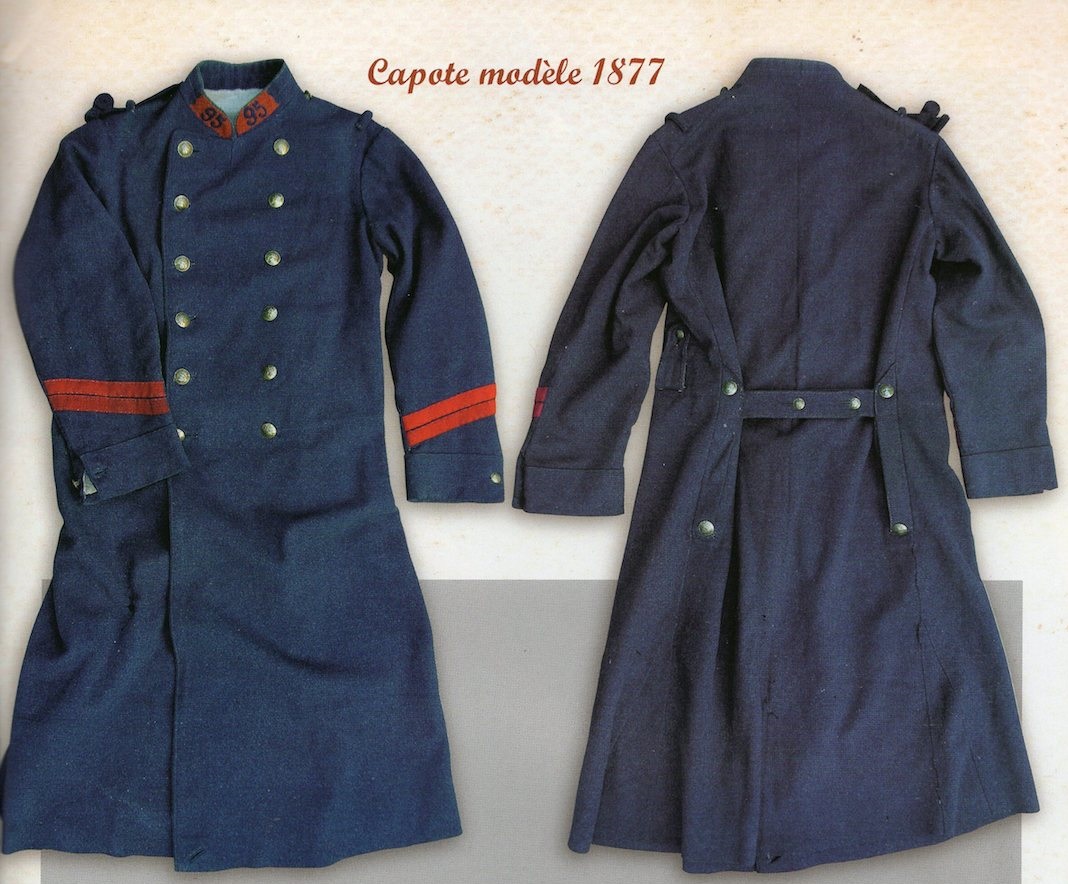
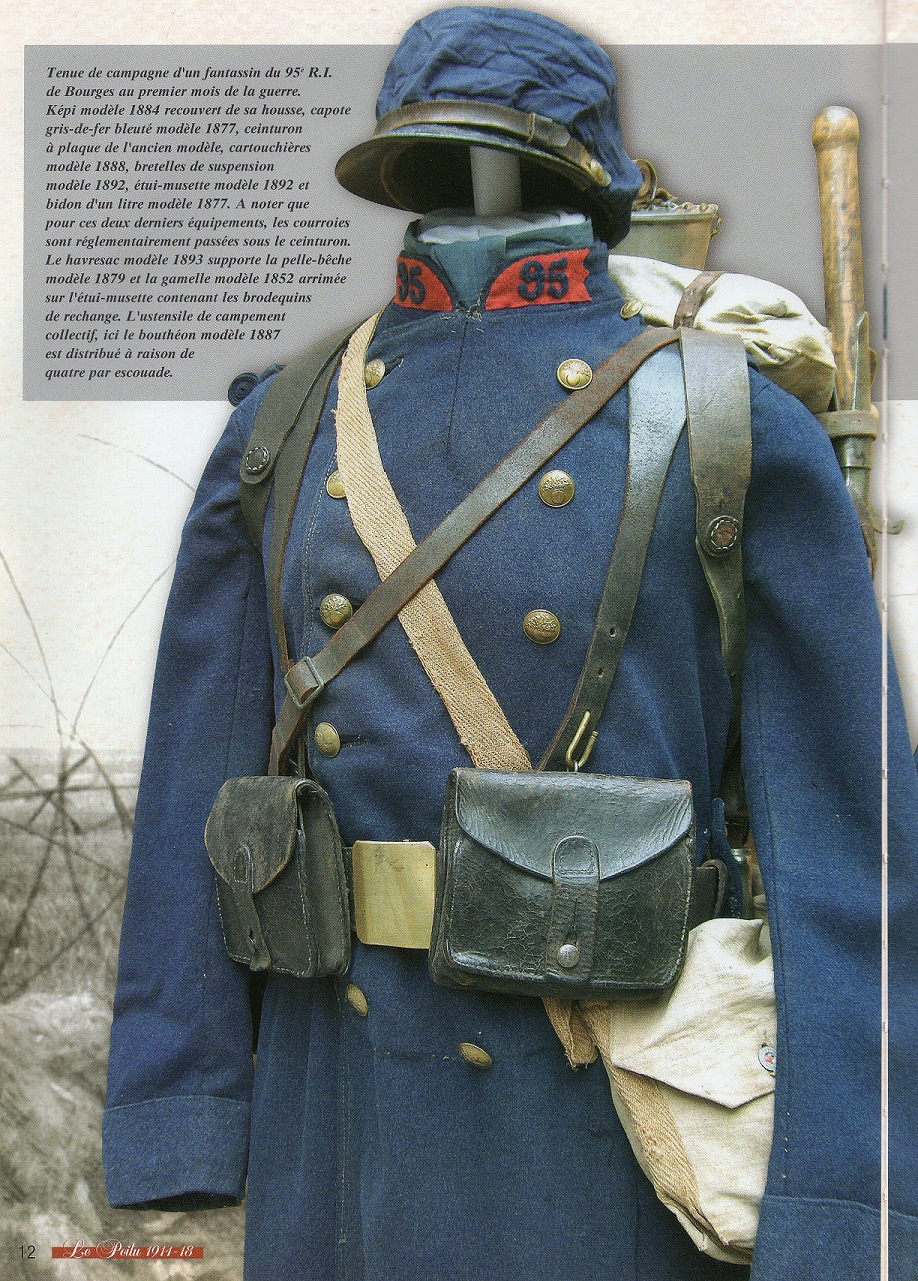

Non-regulation Model 1877 greatcoats appear in 1914 which consist of only a single row of buttons down either the right or left chest alternately. This could be chalked up to a cost and time-saving measure. Though much less common than the regulation pattern, photographic evidence shows them being distributed to various combat units.
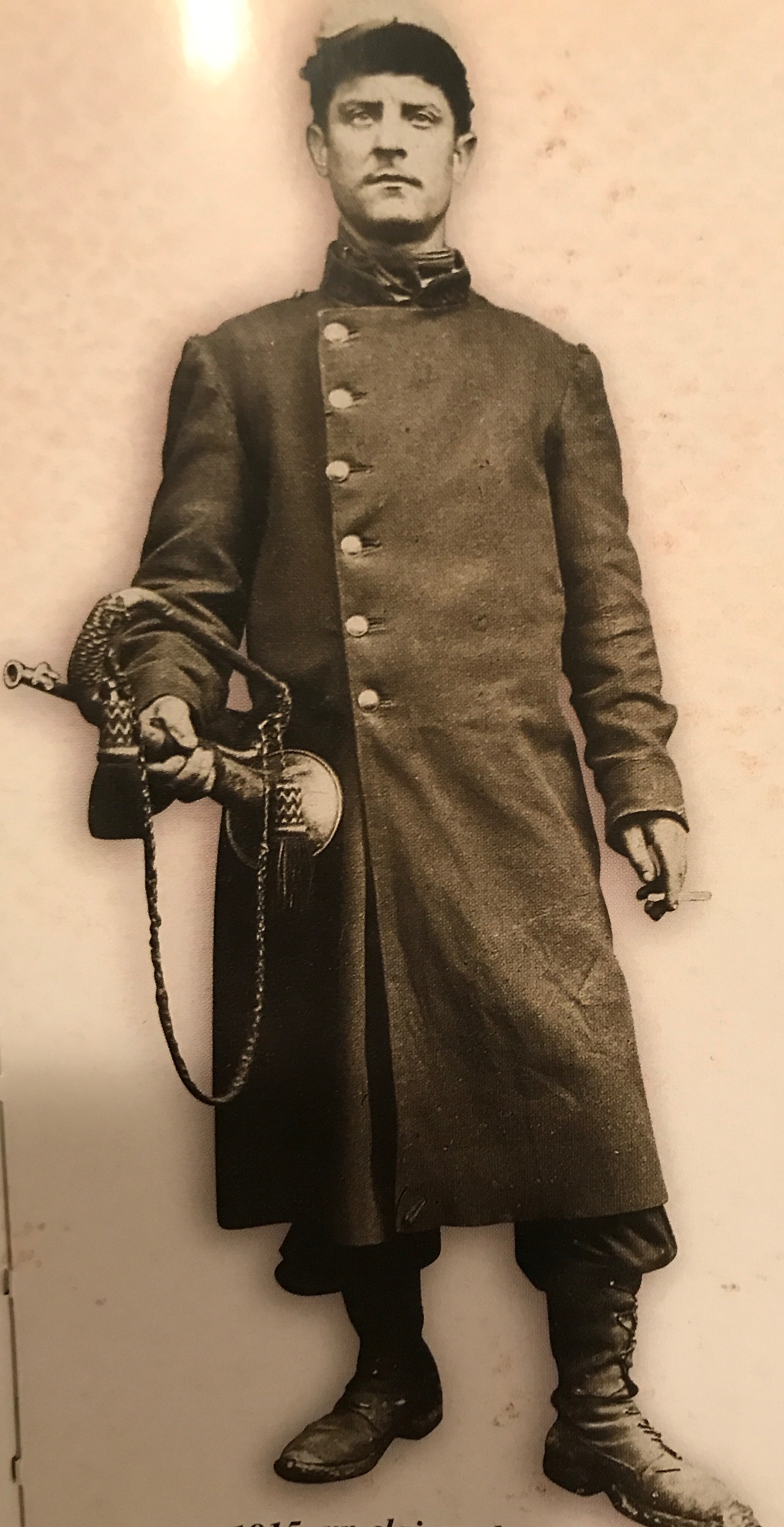

Nearly identical in design to the Model 1877, modified '14 was produced in light blue wool; double-breasted with two rows of six buttons. The buttons, collar patches, martingale, belt loop, shoulder straps and shoulder loops are the same as those on the Model 1877. Regulations stated that the collar should be a standing one, though half-chevalière, or fall-down, collars were also used. The modified '14 no longer has facings or buttons on the cuffs. As the first stocks of new light blue cloth arrived in August, certain manufacturers produce items that, in the absence of official directives from the War Ministry, integrally preserve the pre-war uniform cut. It isn't until the end of September that the description of the new uniform (Model 1914) is sent out. It was in this short lapse of time that a significant amount of the Model 1877/14 greatcoats were produced using the new wool. However, once the army had released the description of the much more simplified Model 1914, it became immediately clear that it would be less costly and time-consuming to produce. Thus, after only a month of production, manufacturers quickly switched to making the regulation model. Still Model 1877/14s remained in limited distribution through the fall of 1914.

Also known as the 'Poiret', after the famous designer who was employed in its creation, the Model 1914 1st Type was introduced in September 1914, is much more rudimentary in design than the Model 1877. It was manufactured in the new "light blue" cloth. The initial batches of the new cloth were made in various shades of wool, ranging from actual light blue to medium blue to dark blue-gray (or "English" cloth as it was called). The coat is single-breasted with one row of six buttons. The body of is made from one single piece of fabric, save for two triangular pieces (or gussets) added to the bottom back of the coat. All seams and hems are left unfinished and open. The sleeves no longer incorporate facings nor buttons on the cuffs, and the martingale (the half-belt on the lower back) has been removed.
Regulations stated that two exterior breast pockets were to be added and another on the interior of the bottom right breast (intended to hold the individual bandage). However, the rear vertical pockets were eliminated. The stand-up collar is done away with in favor of a fall-down (chevalière) one. However, the old collar patches, consisting of the regimental numerals in iron blue sewn onto a madder patch, are retained. In some cases only the left collar patch was sewn on. The buttons on the coat vary widely. While the original brass buttons are still used, beginning in October, they were to be bronzed or burnished to be less shiny. Ersatz measures were also taken in order to meet supply demands and buttons made of horn, wood (covered in cloth), smooth metal, and painted brass were all used. The Model 1914 1st Type would see wide distribution, first amongst new recruits and vets returning from convalescence. Existing stocks would be unilaterally modified to fit the description of the 4th Type (see below) beginning in August 1915.
The Model 1914 2nd Type was introduced in November 1914 and differed from the 1st Type by the abolishment of the outside left breast pocket, and in some cases both breast pockets. Distribution of Model 1914 2nd Type were limited, as the official announcement of the 3rd Type would come only a month later.
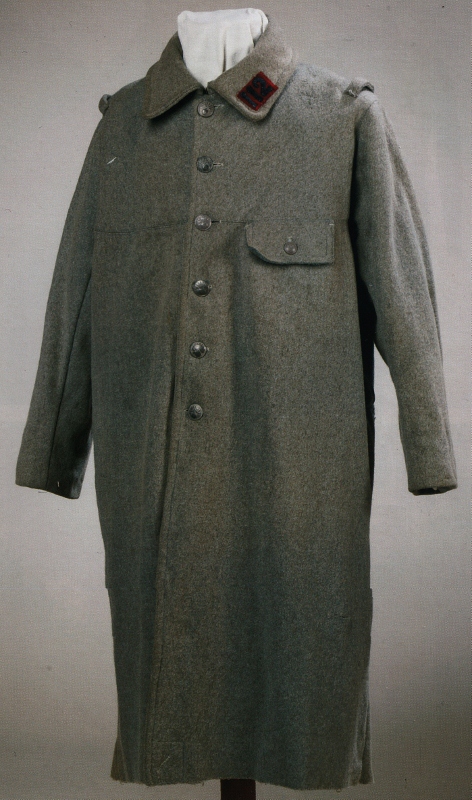
The Model 1914 3rd Type was introduced in December 1914 and saw the return of the outside breast pockets and rear vertical pockets. Two interior pockets were added to either side of the chest. The martingale was also added back. The model 1914 3rd Type did not begin appearing at the front until early 1915. Their presence was widespread until the introduction of the 4th Type (and final type of Poiret) in the summer of 1915, when any existing stocks were modified to fit the description of the latter.
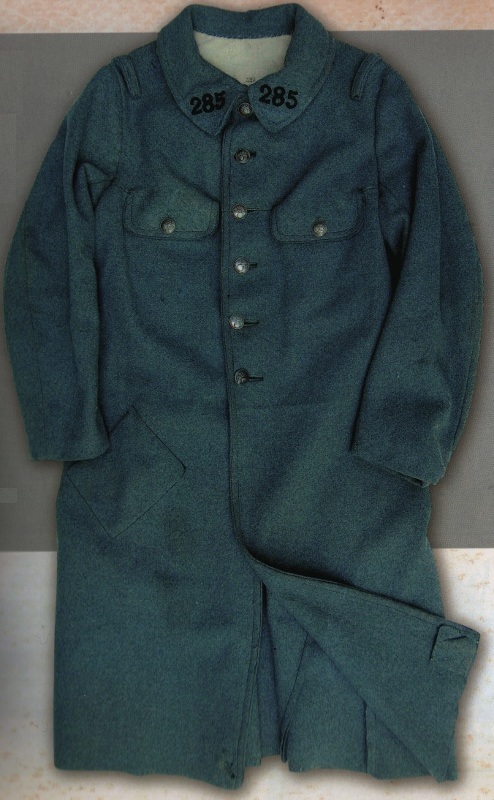.jpg?dl=0)
The Model 1914 4th Type was first introduced in May 1915, by which time a degree of standardization in the color and quality of cloth was starting to be seen. As such, it could be said that the Model 1914/15 4th Type was the first greatcoat to be made originally in what would become the norm for uniform cloth: "horizon-blue" wool. Yet less than the type of cloth used in this model, it was the addition of two pockets that really defines the new model greatcoat. Since the beginning of the war, it was apparent that the distribution of ammo, carried in the cartridge pouches, was insufficient, particularly when resupply had to occur over difficult terrain. In May 1915, a new regulation was handed down, which stated that special pockets made of strong canvas were to be sewn on the inside waist of the coat and supported by a strap of canvas webbing passing over the shoulders of the man. These straps were to be sewn onto the inside of the coat's lining, though in some cases, they were sewn to the outside of the lining. The pockets themselves would have outside flaps that could be buttoned down. In August 1915, it was further declared that all models of greatcoat currently in distribution should have these ammo pockets added to them. As a result, the cloth used for the flaps of the new pockets were often of a different shade than the cloth originally used in these pre-existing coats.
The ersatz buttons used on earlier models had faded somewhat from use and typically the Model 1914 4th Type greatcoat employed buttons made of either bronzed or painted brass. Starting in October 1915 buttons began to be made in aluminum and a month later, in tin and zinc (in two parts). Because earlier models of the coat were modified by the addition of the waist pockets (a modification that was to be completed by November), it's more difficult to delineate when the 4th Type Poiret began general distribution. It seems fair to say that by late summer the 4th Type was showing up in numbers and by the fall, most soldiers at the front were wearing one. The 4th Type was still in limited distribution by the summer of 1917 as stocks were gradually exhausted, and the Model 1915 replaced it entirely by the end of the year.
.jpg?dl=0)
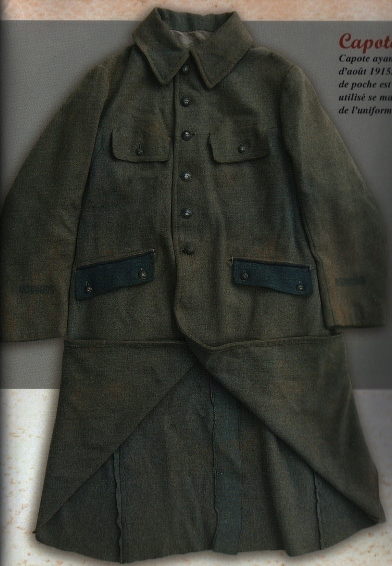.jpg?dl=0)
The variety in the color and quality of cloth of the Poiret coats, especially after several months of exposure and use, had resulted in a lack of uniformity in the French ranks. Even with the initial adoption of the single-breasted, simplified designs, there quickly arose a number of critics. To silence them, army commanders decided to return to the double-breasted cut. Such a design, it was also argued, afforded better protection against the rain and cold. Many elements of the pre-war greatcoat were brought back, while also retaining the war-time modifications that had been developed. The new greatcoat was officially adopted in August 1915.
Thus, the basic design of the Model 1915 would be that of the Model 1877 with a number of differences. It had the two large cartridge pockets reinforced with a strap of canvas webbing (as on the Model 1914 4th Type), the flap closed by two small bomb buttons. The collar would be a fall-down (chevalière) one, with a button-on cloth tab on the left underside that would maintain the collar upright when the collar was flipped up in cold weather. The rear vertical pockets were replaced with simple vents permitting the wearer to reach the pockets of his pants. The cuff facings, accompanied by vents closed by a small bomb button, are also reintroduced. Aside from some minor variance in shades, gradually becoming less and less perceptible, the "horizon-blue" cloth being fabricated by this time was more standardized in color and quality. It was thought then that the Model 1915 was finally a worthy uniform piece for the army.
However, the existing stocks of Poirets first had to be exhausted before the army could allow for the Model 1915s to be distributed. It would not be until the late summer of 1916 that significant stocks of the Model 1915 would be distributed. Meanwhile, Model 1914s continued to be distributed and worn well into 1917. While it appears that most infantrymen were outfitted in the Model 1915 by the summer of '17, it would not be until the end of the year before there existed only one model of greatcoat in service.
